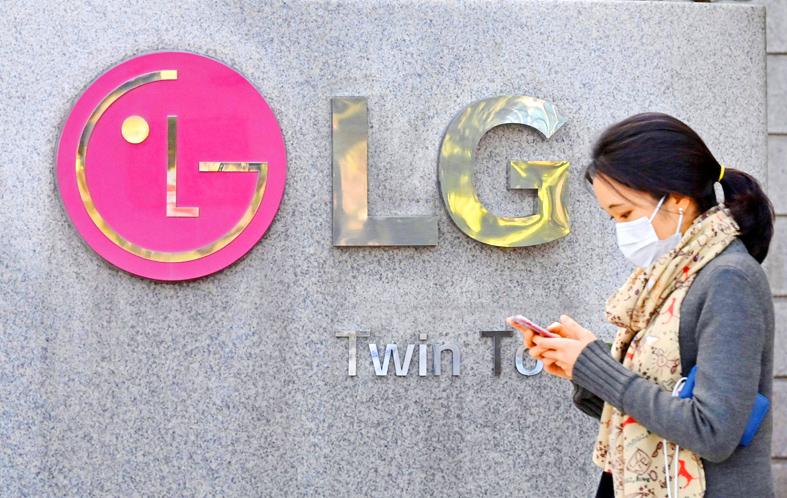South Korea’s LG Electronics Inc is to wind down its loss-making mobile division after failing to find a buyer, a move that would make it the first major smartphone brand to completely withdraw from the market.
Its decision to pull out will leave its 10 percent share in North America, where it is the No. 3 brand, to be gobbled up by Samsung Electronics Co and Apple Inc with its domestic rival expected to have the edge.
“In the United States, LG has targeted mid-priced — if not ultra-low — models and that means Samsung, which has more mid-priced product lines than Apple, will be better able to attract LG users,” Hi Investment & Securities Co analyst Ko Eui-young said.

Photo: AFP
LG’s smartphone division has logged nearly six years of losses totaling about US$4.5 billion.
Dropping out of the fiercely competitive sector would allow LG to focus on growth areas such as electric vehicle components, connected devices and smart homes, it said in a statement.
In better times, LG was early to market with a number of cellphone innovations including ultra-wide-angle cameras and at its peak in 2013, it was the world’s third-largest smartphone manufacturer behind Samsung and Apple.
Later, its flagship models suffered from software and hardware mishaps, which combined with slower software updates saw the brand steadily slip in favor. Analysts have also criticized the company for lack of expertise in marketing compared with Chinese rivals.
While other well-known mobile brands such as Nokia Oyj, HTC Corp (宏達電) and BlackBerry Ltd have also fallen from lofty heights, they have yet to disappear completely.
LG’s current global share is only about 2 percent. It shipped 23 million phones last year, which compares with 256 million for Samsung, according to research provider Counterpoint.
In addition to North America, it does have a sizeable presence in Latin America, where it ranks as the No. 5 brand.
LG’s smartphone division, the smallest of its five divisions accounting for about 7 percent of revenue, is expected to be wound down by July 31.
In South Korea, the division’s employees would be moved to other LG Electronics businesses and affiliates, while elsewhere decisions on employment would be made at the local level.
Analysts said they were told in a conference call that LG plans to retain its 4G and 5G core technology patents as well as core R&D personnel, and would continue to develop communication technologies for 6G.
It has yet to decide whether to license out such intellectual property in the future, they added.
LG would provide service support and software updates for customers of existing mobile products for a period of time that would vary by region, it said.
LG shares have risen about 7 percent since a January announcement that it was considering all options for the business.
Talks to sell part of the business to Vietnam’s Vingroup JSC fell through due to differences about terms, sources with knowledge of the matter have said.

The US dollar was trading at NT$29.7 at 10am today on the Taipei Foreign Exchange, as the New Taiwan dollar gained NT$1.364 from the previous close last week. The NT dollar continued to rise today, after surging 3.07 percent on Friday. After opening at NT$30.91, the NT dollar gained more than NT$1 in just 15 minutes, briefly passing the NT$30 mark. Before the US Department of the Treasury's semi-annual currency report came out, expectations that the NT dollar would keep rising were already building. The NT dollar on Friday closed at NT$31.064, up by NT$0.953 — a 3.07 percent single-day gain. Today,

‘SHORT TERM’: The local currency would likely remain strong in the near term, driven by anticipated US trade pressure, capital inflows and expectations of a US Fed rate cut The US dollar is expected to fall below NT$30 in the near term, as traders anticipate increased pressure from Washington for Taiwan to allow the New Taiwan dollar to appreciate, Cathay United Bank (國泰世華銀行) chief economist Lin Chi-chao (林啟超) said. Following a sharp drop in the greenback against the NT dollar on Friday, Lin told the Central News Agency that the local currency is likely to remain strong in the short term, driven in part by market psychology surrounding anticipated US policy pressure. On Friday, the US dollar fell NT$0.953, or 3.07 percent, closing at NT$31.064 — its lowest level since Jan.

Hong Kong authorities ramped up sales of the local dollar as the greenback’s slide threatened the foreign-exchange peg. The Hong Kong Monetary Authority (HKMA) sold a record HK$60.5 billion (US$7.8 billion) of the city’s currency, according to an alert sent on its Bloomberg page yesterday in Asia, after it tested the upper end of its trading band. That added to the HK$56.1 billion of sales versus the greenback since Friday. The rapid intervention signals efforts from the city’s authorities to limit the local currency’s moves within its HK$7.75 to HK$7.85 per US dollar trading band. Heavy sales of the local dollar by

The Financial Supervisory Commission (FSC) yesterday met with some of the nation’s largest insurance companies as a skyrocketing New Taiwan dollar piles pressure on their hundreds of billions of dollars in US bond investments. The commission has asked some life insurance firms, among the biggest Asian holders of US debt, to discuss how the rapidly strengthening NT dollar has impacted their operations, people familiar with the matter said. The meeting took place as the NT dollar jumped as much as 5 percent yesterday, its biggest intraday gain in more than three decades. The local currency surged as exporters rushed to